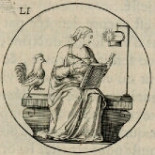Sentiments of a penitent soul
Laidronnette, the noble but ugly heroine of Madame d’Aulnoy’s fairy tale “Serpentin vert,” begs her royal parents to “allow her to go and shut herself away in the Lonely Castle, to hide her ugliness, and to spare them any further misery. […] She stayed two years in this pleasant solitude, and even wrote various books of thoughts and meditations (quelques Livres de reflections).”1
Laidronnette’s solitary writings evoke a subset of d’Aulnoy’s own literary production that is forgotten today but was quite successful in her time and constantly republished in the eighteenth century: two biblical paraphrases accompanied by a series of Réflexions chrétiennes.2 The author first mentioned these prose works in the preface to her 1693 Nouvelles ou Mémoires historiques, a chronicle of the Franco-Dutch War of 1672-79. The list of seven earlier publications that she acknowledges as her own includes memoirs, novels, and novellas, but also:
Une Paraphrase sur le Miserere.
Une Paraphrase sur le Pseaume Benedic anima mea Domino.
As I have shown before, all these books were written while d’Aulnoy herself was living in a “pleasant solitude,” that of the Parisian convent of the Hospitalières de la Miséricorde de Jésus – not at her own request, but by order of King Louis XIV.
The analysis of d’Aulnoy’s devotional writings has been hampered by the fact that the earliest known edition was the one published at the end of 1697 by Catherine Legras, widow of the bookseller Théodore Girard. Dated 1698, this volume combines the two psalm paraphrases along with eight Réflexions chrétiennes. It contains two “approbations” by the Sorbonne theologian Edmond Pirot dated October 2, 1690, and April 22, 1691, and a royal “privilège” dated November 14, 1697. In the absence of copies of earlier editions, scholars were left to wonder whether these texts had in fact been printed before or only circulated in manuscript.
Today, thanks to the easier access to library catalogues from around the world, at least three copies of the first edition of the Miserere paraphrase can be located: in Madrid (Biblioteca Nacional de España), Monza (Biblioteca civica), and Amiens (Bibliothèque municipale). They reveal that this work was indeed printed in 1691 for Claude Barbin, the popular Paris bookseller who also published most of d’Aulnoy’s secular writings. The author appears on the title page as “Madame **.”


This first edition includes Pirot’s “approbation” but no royal “privilège.” Instead, its printing is authorized by a simple “permis d’imprimer” signed by the Lieutenant of Police, Gabriel Nicolas de La Reynie, and dated June 16, 1691.
The paraphrase is followed by eight Christian Reflections on our Weaknesses (p. 137-166), which thus turn out to have been part of this first edition and not a later addendum. They appear to be d’Aulnoy’s own work, whereas posthumous editions (starting in 1709) supplement her texts with additional reflections taken from other authors.

As for the other paraphrase, on the psalm Benedic anima mea Domino, its first edition remains elusive but will hopefully also resurface somewhere some day. Its “approbation” is dated earlier than the one for the Miserere, which may indicate that d’Aulnoy wrote it first; on the other hand, it appears in second position in her 1693 list of publications, as well as in the collected editions. In any case, it seems safe to assume that it too was published by Claude Barbin. It was not until the fall of 1697, following the publication of Les Contes des fées, that d’Aulnoy ended her association with Barbin and entrusted her subsequent books to Catherine Legras and her successor Nicolas Gosselin.
The biblical paraphrases and Christian reflections were not the only edifying texts written by d’Aulnoy during her stay in the convent. In August 1693, the fashionable monthly Mercure galant published the story of a young Chinese noblewoman, named Ina, whose incredible adventures had recently led her from Beijing to Paris. Following a storm at sea, naval combat, and a harrowing two-year odyssey in the hands of Dutch and French corsairs, she ended up all alone in the middle of the rue Saint-Denis and was given shelter and support by a charitable lady. When this unusually good treatment made her fall sick, Ina was taken in by the Hospitalières of the rue Mouffetard – the same nuns with whom d’Aulnoy had been living for the past six years. Eagerly learning the French language and discovering the true Christian religion, this “poor foreigner” was now safely “in the arms of Providence,” who would take care of the rest.

This (allegedly true) story is presented as a letter dated from the “Hospitalières du Fauxbourg S. Marceau” on July 12, 1693. Its author is not named, but described as “a person distinguished by her wit and her birth” who is “retired with her [Ina] in a place ruled by virtue alone.” Readers familiar with the life and style of Madame d’Aulnoy must have been able to recognize her in these pages of the Mercure; her authorship is explicitly confirmed by a contemporary source.3 This short story of adventure, abjection, and conversion certainly deserves to be added to the works of this amazingly prolific, versatile, and talented writer.
Volker Schröder
January 11, 2021

Footnotes
1. “The Great Green Worm,” translated by A.S. Byatt, in Wonder Tales, ed. Marina Warner, New York: Farrar, Straus and Giroux, 1996, p. 193.
2. For a critical study of the text, see Allison Stedman, “Sacred Writings, Secular Identities: d’Aulnoy’s Manipulation of the Psalm-Paraphrase Tradition,” in Intersections: Actes du 35e congrès annuel de la North American Society for Seventeenth-Century French Literature, ed. Faith E. Beasley & Kathleen Wine, Tübingen: Narr, 2005, p. 347-356. For an overview of the genre, see Claire Fourquet-Gracieux, Les Jeux de l’esprit: tourner les psaumes en français (1650-1715), Paris: Classiques Garnier, 2020.
3. Père Léonard de Sainte-Catherine de Sienne, BnF Manuscrits Français 22580, f. 129.
